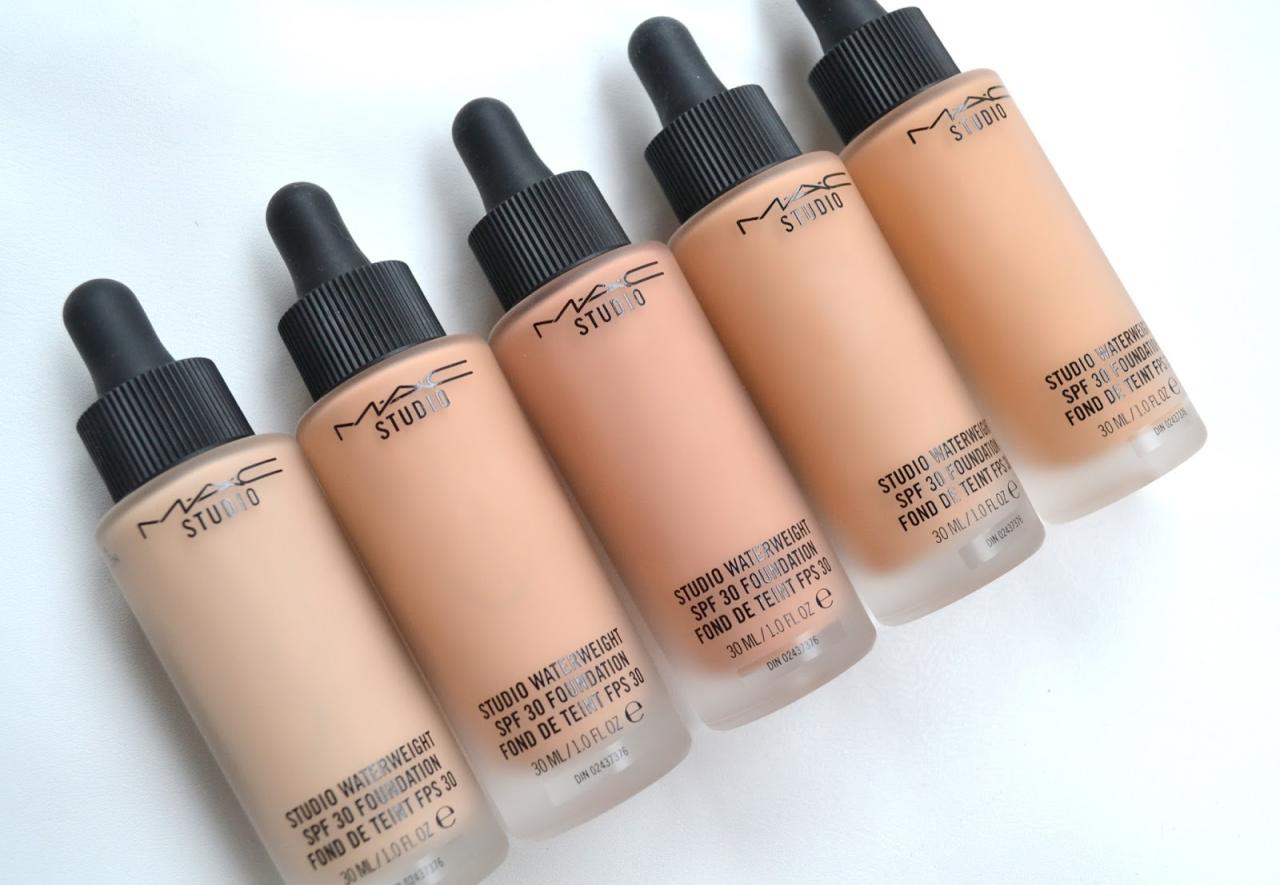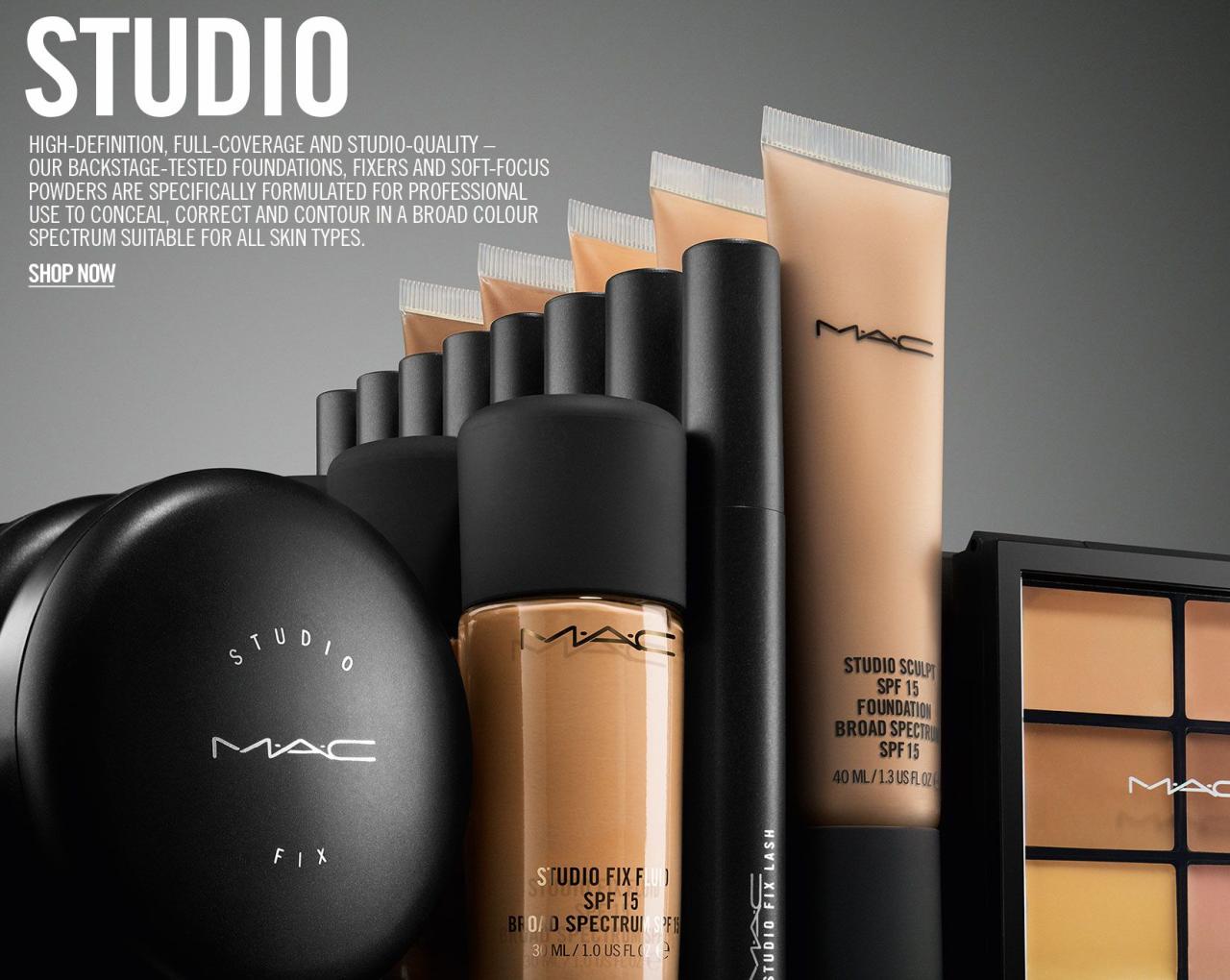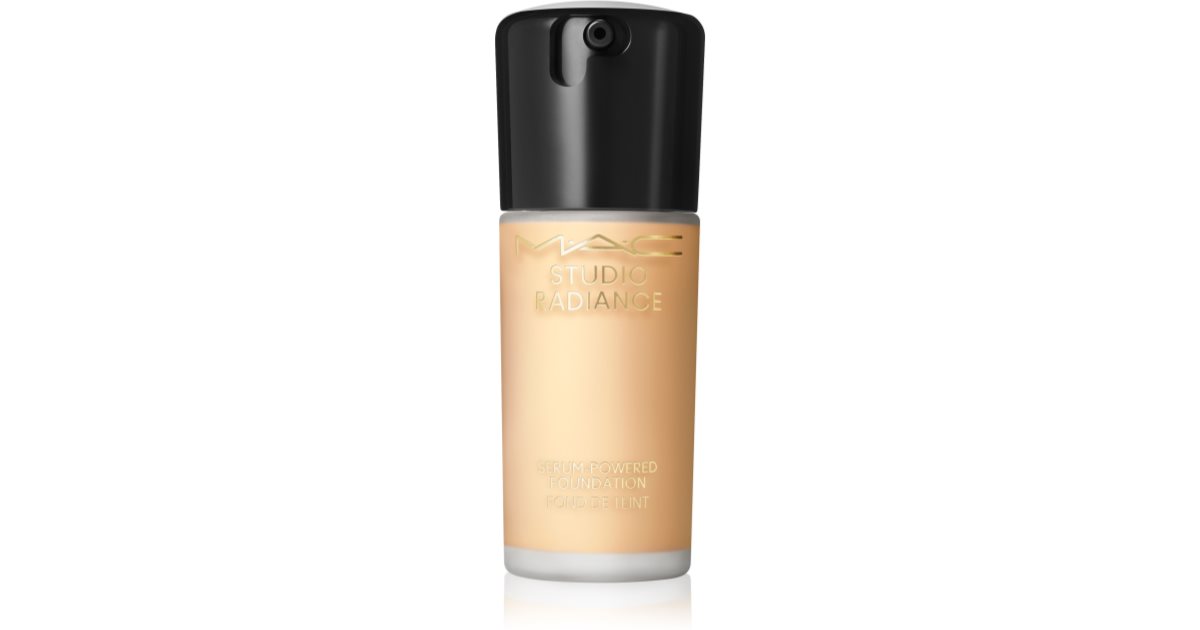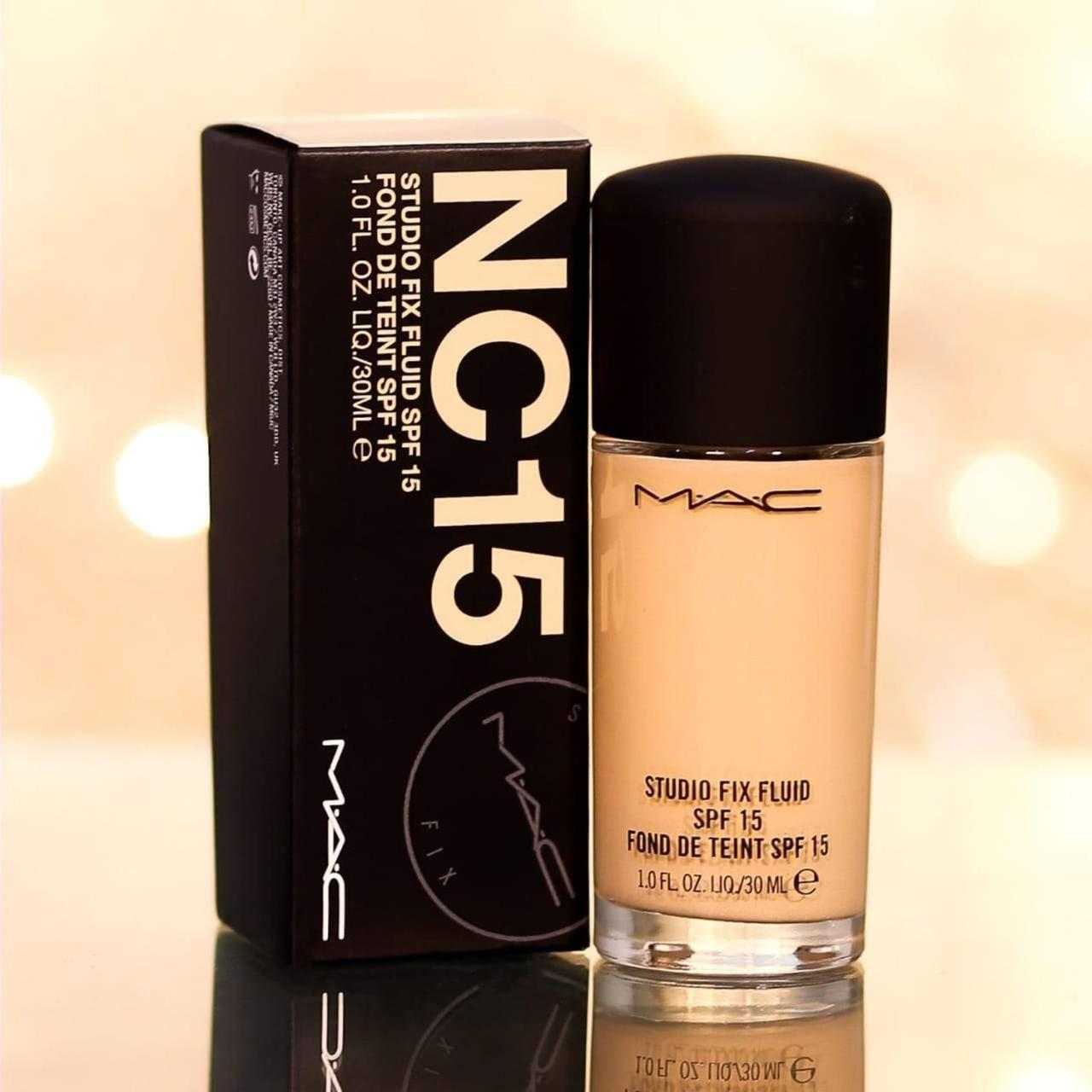Mac foundation is a staple in many makeup bags, known for its wide shade range and various formulations. This guide dives deep into the world of MAC cosmetics, exploring its diverse foundation options, application techniques, and comparisons with competitor brands. We’ll cover everything from understanding undertones and choosing the right shade to mastering application techniques for a flawless finish.
Get ready to become a MAC foundation expert!
We’ll break down the different MAC foundation types – liquid, cream, powder – and their corresponding finishes: matte, satin, luminous. We’ll also compare MAC to other popular brands, considering factors like price, longevity, and coverage. By the end, you’ll be equipped to confidently select and apply the perfect MAC foundation for your skin type and desired look.
Mac Foundation Shades & Undertones
Choosing the right foundation shade can be tricky, but understanding undertones and MAC’s shade range simplifies the process. MAC offers a vast selection, catering to a wide variety of skin tones and preferences. This information will help you navigate their options and find your perfect match.
Mac Foundation Shade Range
MAC boasts several popular foundation lines, each with its own shade range. The Studio Fix Fluid SPF 15, for example, offers a broad spectrum of shades, from very fair to deep dark. Their Studio Radiance, known for its luminous finish, also has an extensive shade range. The specific number of shades varies by line, but generally, you’ll find numerous options within each line to accommodate different skin depths.
These ranges are designed to be inclusive, aiming to represent a diverse range of skin tones.
Understanding Undertone Classifications
MAC categorizes its foundations based on undertones: cool, warm, and neutral. Understanding your undertone is crucial for a flawless match. Cool undertones have blue, pink, or red undertones; think of the veins on your inner wrist appearing bluish. Warm undertones have yellow or golden undertones; your veins might appear greenish. Neutral undertones blend aspects of both cool and warm, appearing neither distinctly blue nor green.
Identifying your undertone ensures the foundation blends seamlessly with your skin, avoiding an unnatural or mask-like appearance.
Mac Foundation Shade Examples for Various Skin Tones
The following table provides examples of MAC foundation shades suitable for various skin tones, considering undertones. Remember that shade names and availability may vary slightly depending on the specific foundation line. It’s always recommended to test shades in person for the most accurate match.
| Shade Name | Shade Description | Undertone | Suitable Skin Tone |
|---|---|---|---|
| NW15 | Very Fair with Neutral Undertones | Neutral | Very fair skin with neutral undertones |
| C1 | Fair with Cool Undertones | Cool | Fair skin with pink or blue undertones |
| NC15 | Fair with Warm Undertones | Warm | Fair skin with yellow or golden undertones |
| NW25 | Light Beige with Neutral Undertones | Neutral | Light beige skin with neutral undertones |
| C4 | Light Medium with Cool Undertones | Cool | Light medium skin with pink or blue undertones |
| NC25 | Light Medium with Warm Undertones | Warm | Light medium skin with yellow or golden undertones |
| NW45 | Medium Tan with Neutral Undertones | Neutral | Medium tan skin with neutral undertones |
| C7 | Medium Deep with Cool Undertones | Cool | Medium deep skin with pink or blue undertones |
| NC45 | Medium Deep with Warm Undertones | Warm | Medium deep skin with yellow or golden undertones |
Mac Foundation Formulations & Finishes

Choosing the right MAC foundation involves understanding its various formulations and finishes. The perfect foundation depends on your skin type, desired coverage, and personal preference. Let’s break down the key differences to help you find your ideal match.
MAC offers a wide range of foundation formulations, each designed to cater to different skin types and preferences. These formulations impact not only the application but also the overall look and feel of the makeup. The finish, on the other hand, refers to the final appearance of the foundation on the skin, ranging from matte to dewy. Understanding both aspects is crucial for making an informed choice.
Foundation Formulations
MAC’s foundation formulations primarily fall into liquid, cream, and powder categories, each with its own set of advantages and disadvantages. Liquid foundations are generally the most versatile, offering buildable coverage and a wide range of finishes. Cream foundations provide medium to full coverage with a more emollient feel, often preferred by those with dry skin. Powder foundations offer the least coverage, but are excellent for touch-ups and setting other makeup.
Foundation Finishes
The finish of a MAC foundation significantly impacts the overall look. Matte finishes are ideal for oily skin, providing a non-shiny appearance. Satin finishes offer a subtle sheen, balancing between matte and luminous. Luminous or dewy finishes create a radiant, glowing effect, perfect for dry or mature skin. Choosing the right finish depends largely on your skin type and personal preference for a natural or more polished look.
Comparison of MAC Foundation Formulations and Finishes
The following table compares five popular MAC foundation formulations, highlighting their key features. Remember that individual experiences may vary.
| Foundation Name | Formulation | Finish | Coverage | Best For |
|---|---|---|---|---|
| Studio Radiance Face and Body | Liquid | Luminous | Sheer to Medium | Normal to Dry Skin, Natural Look |
| Studio Fix Fluid | Liquid | Matte | Medium to Full | Oily to Combination Skin, Full Coverage |
| Studio Fix Powder Plus Foundation | Powder | Matte | Medium to Full | Oily Skin, Touch-Ups, Setting Powder |
| Face and Body Foundation | Liquid | Natural | Sheer to Light | All Skin Types, Natural Look |
| Studio Sculpt SPF 15 | Cream | Satin | Medium to Full | Combination to Dry Skin, Buildable Coverage |
Application Techniques for Mac Foundation

Applying MAC foundation flawlessly hinges on choosing the right tools and technique for your desired finish. Whether you prefer a natural, dewy look or a more full-coverage, matte effect, the application method significantly impacts the final result. This section will guide you through various techniques to achieve a seamless, professional-looking makeup application.
Choosing Your Application Tools
The tool you select greatly influences the final look and feel of your foundation. Different tools offer varying levels of coverage and finish. Sponges provide a more natural, blended finish, while brushes allow for more precise application and control, especially for areas requiring more coverage. Using your fingers can create a warm, dewy look, but may not be ideal for achieving a completely even application.
Applying MAC Foundation with a Brush
For a precise and controlled application, a foundation brush is a great option. High-quality synthetic brushes are generally preferred for liquid foundations, while natural hair brushes can be used, but require more cleaning.
Applying MAC Foundation with a Sponge
Dampening a beauty sponge before application helps to create a more seamless and airbrushed finish. This technique is ideal for achieving a natural, lightweight look. Use a stippling motion to gently press the foundation into the skin.
Applying MAC Foundation with Fingers
Applying foundation with your fingers can create a warmer, more natural finish, particularly suitable for those seeking a less-structured application. The warmth of your fingers helps blend the product seamlessly into your skin. However, ensure your hands are clean to avoid transferring bacteria or oils.
Step-by-Step Tutorial: Applying MAC Studio Fix Fluid Foundation
- Prep Your Skin: Start with a clean, moisturized face. Allow your moisturizer to fully absorb before applying any makeup. This ensures a smooth base and prevents a cakey look.
- Dispense Foundation: Apply a small amount of MAC Studio Fix Fluid foundation onto the back of your hand or directly onto your face (if using fingers). A pea-sized amount is usually sufficient for one section of your face.
- Apply Foundation: Using your chosen tool (brush, sponge, or fingers), begin applying the foundation to the center of your face, working outwards. Start with larger sections, and then focus on smaller areas needing extra coverage.
- Blend Seamlessly: Use gentle, dabbing or stippling motions to blend the foundation into your skin. Avoid harsh rubbing, which can disrupt the skin’s natural texture and cause streaking. Focus on blending at the hairline, jawline, and neck to prevent visible lines of demarcation.
- Build Coverage as Needed: If you require more coverage in certain areas (such as blemishes or redness), apply additional foundation to those spots and blend carefully. This layering technique allows for customizable coverage.
- Set with Powder (Optional): To set your foundation and enhance its longevity, apply a translucent powder using a large, fluffy brush. This helps to control shine and create a more matte finish, if desired.
Blending Tips and Tricks
Blending is key to achieving a natural-looking finish. Using gentle, circular motions or stippling with your chosen tool ensures a seamless transition between areas of different coverage. Pay close attention to the hairline, jawline, and neck to prevent visible lines. A damp sponge is especially helpful in achieving a flawless blend.
MAC Foundation Comparisons with Competitors
Choosing the right foundation can feel overwhelming, especially with so many brands offering a vast array of options. This section compares MAC Cosmetics foundation with three leading competitors, highlighting key differences to help you make an informed decision. We’ll look at price points, coverage, how long the makeup lasts, and the overall finish each provides.
MAC Foundation Compared to Competitors: Price, Coverage, Longevity, and Finish
Let’s delve into a direct comparison of MAC Studio Fix Fluid foundation with three popular alternatives: Estée Lauder Double Wear, NARS Sheer Glow, and Fenty Beauty Pro Filt’r Soft Matte Longwear. These brands cater to different needs and preferences, making a side-by-side analysis beneficial.
| Brand | Foundation Name | Key Features | Price Range (USD) |
|---|---|---|---|
| MAC | Studio Fix Fluid SPF 15 | Medium to full buildable coverage, matte finish, long-lasting wear (up to 12 hours), wide shade range. Suitable for various skin types but may be drying for very dry skin. | $38 – $40 |
| Estée Lauder | Double Wear Stay-in-Place Foundation | Full coverage, matte finish, extremely long-lasting wear (up to 24 hours), known for its staying power, wide shade range. Can feel heavy on some skin types. | $49 – $52 |
| NARS | Sheer Glow Foundation | Medium buildable coverage, natural radiant finish, comfortable wear, less long-lasting than MAC or Estée Lauder (around 8 hours). Suitable for normal to dry skin. | $49 – $52 |
| Fenty Beauty | Pro Filt’r Soft Matte Longwear Foundation | Medium to full buildable coverage, soft matte finish, long-lasting wear (up to 12 hours), inclusive shade range praised for its diversity. Can be slightly drying for some. | $36 – $38 |
Target Audience for Each Brand and Foundation Line
The target audience varies significantly across these brands. MAC caters to a broad demographic, appealing to makeup enthusiasts and professionals alike, offering a wide range of products and finishes. Estée Lauder targets a more mature, sophisticated customer base, focusing on high-performance, luxurious products. NARS attracts a fashion-forward audience who value natural-looking makeup with a focus on quality and sophisticated shades.
Fenty Beauty has built a strong following amongst diverse consumers, emphasizing inclusivity and a wide shade range designed to cater to all skin tones. Their foundation reflects this commitment to diversity and inclusivity.
Mac Foundation Ingredients & Concerns

Choosing the right foundation involves understanding its ingredients. MAC, like other makeup brands, uses a range of ingredients in its foundation formulations, some of which might cause reactions in sensitive skin. Knowing what’s in your makeup can help you make informed decisions and potentially avoid skin irritation.Knowing the ingredients in your MAC foundation allows you to make informed choices about your skincare routine.
Some ingredients, while beneficial for creating a long-lasting or buildable finish, might be problematic for individuals with specific allergies or sensitivities. Understanding these ingredients and their potential effects is crucial for maintaining healthy skin.
Common Ingredients in MAC Foundations
MAC foundations utilize a variety of ingredients to achieve different finishes and effects. These ingredients contribute to the texture, coverage, and longevity of the product. While the exact composition varies between different foundation formulations, some common ingredients include pigments for color, emollients for smoothness, and preservatives to extend shelf life. Many formulations also incorporate ingredients intended to provide skin benefits, such as antioxidants or hydrating agents.
Potential Allergens and Irritants in MAC Foundations
Certain ingredients found in MAC foundations have the potential to cause allergic reactions or irritation in some individuals. Fragrances, preservatives like parabens, and certain emulsifiers are common culprits. Individuals with sensitive skin or known allergies should carefully review the ingredient list before purchasing any MAC foundation. Patch testing a small amount on a less sensitive area of skin before full application is always a good precaution.
MAC’s Ingredient Claims
MAC frequently advertises claims about its foundation ingredients, often focusing on aspects like longevity and oil-free formulas. For example, some foundations are marketed as “long-lasting” implying ingredients that help the makeup stay in place for extended periods. Others are labeled “oil-free,” suggesting formulations designed for oily or combination skin types, often using ingredients that absorb excess oil. It’s important to note that these claims are marketing statements and should be considered alongside the full ingredient list.
List of Common Ingredients and Potential Sensitivities
- Titanium Dioxide: A common pigment that provides coverage and sun protection. May cause irritation in some individuals.
- Talc: A mineral often used to create a smooth texture. Can be a potential irritant for some.
- Isopropyl Myristate: An emollient that helps create a smooth application. Can be comedogenic (pore-clogging) for some skin types.
- Fragrance: A common additive that can trigger allergic reactions in sensitive individuals. Look for “fragrance-free” options if you have sensitivities.
- Parabens (e.g., Methylparaben, Propylparaben): Preservatives that extend shelf life. Some individuals experience allergic reactions to parabens.
Customer Reviews & Experiences with Mac Foundation
MAC Cosmetics enjoys a significant presence in the beauty industry, and its foundations are a frequently discussed topic online. Analyzing customer reviews provides valuable insight into user experiences, highlighting both the strengths and weaknesses of the brand’s offerings. This analysis examines common positive and negative feedback, recurring themes related to specific products, and the factors influencing overall customer satisfaction.
Positive Customer Reviews
Many positive reviews praise MAC foundations for their buildable coverage, allowing users to customize the intensity to suit their needs. Another common theme revolves around the longevity of the product; many users report that the foundation lasts all day without significant fading or creasing. The wide shade range is frequently cited as a major plus, catering to a diverse range of skin tones and undertones.
Finally, the availability of various formulations (liquid, cream, powder) allows customers to select a product that best fits their skin type and preferences. For example, one review stated, ” I’ve been using MAC Studio Fix Fluid for years and it’s my holy grail. The coverage is amazing, it lasts all day, and the shade match is perfect.” Another user commented, ” I love the MAC Face and Body foundation for its natural, lightweight feel. It’s perfect for everyday wear.”
Negative Customer Reviews
While many users are satisfied, some negative reviews highlight certain drawbacks. A recurring complaint concerns the price point, with some customers feeling the foundations are too expensive for their budget. Another common criticism involves the potential for oxidation, where the foundation darkens slightly throughout the day. Some users also report experiencing dryness or cakiness, particularly with certain formulations.
Finally, some reviews mention difficulty finding the perfect shade match, despite the wide shade range. One negative review exemplifies this: ” While the coverage is good, the Studio Fix Powder Plus Foundation is too drying for my skin.” Another user wrote, ” I found the shade I ordered oxidized noticeably after a few hours, leaving me with a mismatched look.”
Factors Influencing Customer Satisfaction
Several factors significantly influence customer satisfaction with MAC foundations. The primary factors are shade matching, longevity, finish, and skin type compatibility. A perfect shade match is crucial for a natural and flawless look, while longevity ensures the foundation remains in place throughout the day. The desired finish (matte, dewy, natural) also plays a role, as does the compatibility of the formulation with the individual’s skin type (oily, dry, combination).
For example, a user with oily skin might find a matte foundation more suitable than a dewy one, while someone with dry skin might prefer a hydrating formula. The price point also undeniably influences satisfaction, especially when compared to more affordable alternatives. Ultimately, a positive experience hinges on finding the right product that complements the individual’s skin and preferences.
Mac foundation is a popular choice for many, offering a wide range of shades and finishes. If you’re looking to snag some, check out their selection at the bay canada , a great place to find beauty products. They often have sales and you might even find your perfect shade of Mac foundation there, saving you some cash!
Illustrative Descriptions of Mac Foundation Textures
Choosing the right MAC foundation depends heavily on understanding its texture and how that translates to your skin. Different textures offer varying levels of coverage, finish, and feel, impacting both application and the overall look. Let’s delve into the textures of three popular MAC foundations: Studio Radiance, Studio Fix Fluid, and Face and Body.
So you’re thinking about Mac foundation? Finding the right shade can be tricky! To get that perfect, polished look, you might want to check out the stylish handbags from michael kors – a great way to carry all your makeup essentials. Then, once you’ve got your bag sorted, you can focus on perfecting your Mac foundation application for a flawless finish.
Studio Radiance Texture, Mac foundation
Studio Radiance boasts a lightweight, luminous texture. Imagine a silky, almost creamy consistency that glides effortlessly onto the skin. It feels incredibly smooth, like a luxurious veil, rather than a heavy mask. The texture allows for buildable coverage, starting with a sheer, natural look that can be intensified for more concealing power. This lightweight feel prevents a cakey appearance, even with layering.
So, you’re perfecting your makeup look with MAC foundation – that flawless base is key! Remember to pack it carefully for your next trip, and consider using a sturdy suitcase like the ones from lojel luggage to keep everything safe. That way, your MAC foundation, and everything else, arrives undamaged, ready for your next glamorous event.
The application process is seamless, whether using fingers, a brush, or a sponge. The final result is a radiant, healthy-looking glow. It’s perfect for those who want a natural-looking enhancement rather than full-coverage camouflage.
Studio Fix Fluid Texture
In contrast to Studio Radiance, Studio Fix Fluid offers a medium-to-full coverage with a more substantial texture. Think of a creamy, yet slightly thicker consistency than Studio Radiance. It still blends beautifully, but provides a more noticeable, even finish. The feel on the skin is a balance between comfortable and substantial – not heavy or suffocating, but definitely more noticeable than Studio Radiance.
Application requires a bit more precision, as the higher coverage means mistakes are more visible. A brush or damp sponge often yields the best results for a smooth, even application. The final look is a flawless, perfected complexion with a naturally matte finish. It’s ideal for those seeking more coverage to conceal blemishes or imperfections.
Face and Body Texture
Face and Body offers a completely different experience. Its texture is exceptionally thin and watery, almost like a tinted moisturizer. It feels incredibly lightweight, almost imperceptible on the skin. The low coverage and sheer finish allow your skin’s natural texture to show through. Application is super easy; it blends seamlessly with fingers, a brush, or a sponge.
Because of its thin consistency, building coverage takes more layers, but the final look is extremely natural and breathable. This makes it perfect for a no-makeup makeup look or for those who prefer a lightweight foundation for everyday wear. It’s important to note that due to its sheerness, it’s less effective at concealing imperfections.
Final Summary

Mastering the art of MAC foundation application takes practice, but the results are well worth the effort. Remember to consider your skin type, desired finish, and undertone when making your selection. Experiment with different application techniques and tools to find what works best for you. With the right knowledge and a little practice, you can achieve a flawless, natural-looking finish that enhances your unique beauty.
So, go ahead and explore the world of MAC foundation – your perfect match awaits!
Quick FAQs
What’s the difference between MAC Studio Fix Fluid and Studio Radiance?
Studio Fix Fluid offers medium-to-full coverage with a matte finish, while Studio Radiance provides a more natural, luminous finish with buildable coverage.
How long does MAC foundation typically last?
Longevity varies depending on the formulation and your skin type, but many MAC foundations are known for lasting several hours.
Is MAC foundation suitable for sensitive skin?
MAC offers foundations formulated for sensitive skin, but it’s always best to check the ingredient list for potential irritants and perform a patch test before full application.
Where can I find MAC foundation shade matching guides?
MAC’s website and various beauty blogs offer helpful shade matching guides and tools.